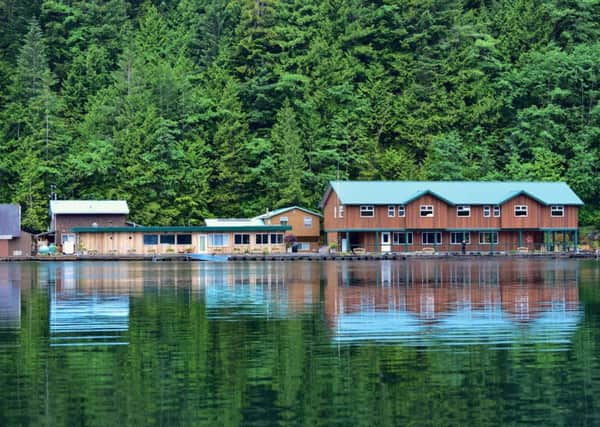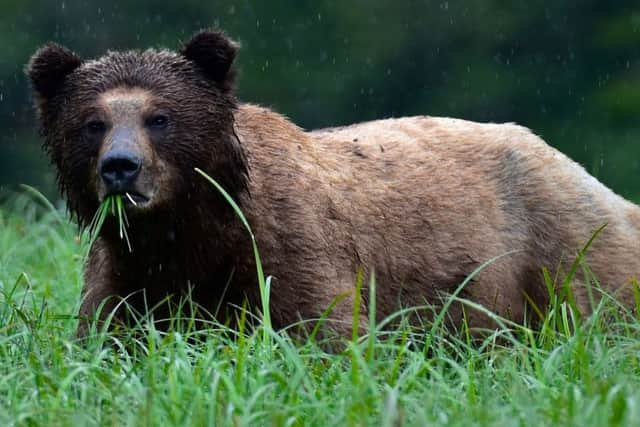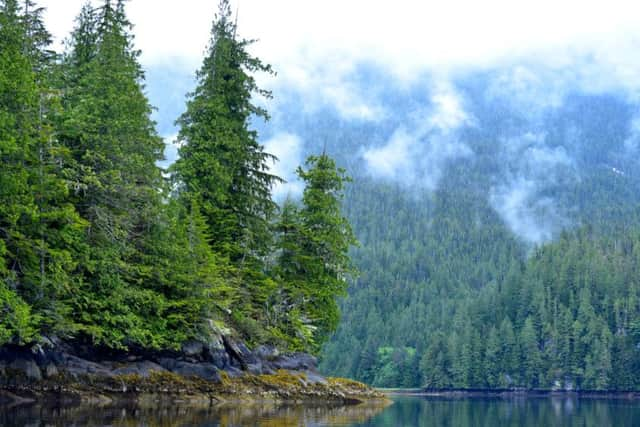Travel: Face to face with grizzly bears in British Columbia


THE grizzly’s powerful presence filled the viewfinder as it stared straight down the barrel of my camera lens. After waiting for what seemed like an eternity, the beautiful female finally emerged from the tall sedge grass to graze by the cold river just a few feet away.
This was my first sighting of a wild grizzly in its natural environment, doing what a bear should be doing, and it was a special and moving moment. I sat perfectly still in a small, motorised tin boat, chilled by the cool, damp evening, having waited ages for this scenario to unfold.
Advertisement
Hide AdI’d come to Great Bear Lodge, 50 miles from Port Hardy, a small town at the top of Vancouver Island, to see wild and uncollared grizzly bears. I wasn’t disappointed.


At Port Hardy, I boarded a rickety de Havilland seaplane and flew low over Queen Charlotte Strait between North Vancouver Island and the mainland. We swooped over the dense rainforest covering the foothills of the north Coast Range Mountains, where the last snows of winter held on to the lofty peaks. Flaps down, the seaplane hovered slightly before dropping into the Smith Inlet and the Nekite River, landing on the water with minimal effort and barely a splash, before drifting towards the dock of our floating lodge.
I stepped off the plane into a landscape like no other. The surrounding inlets were beautiful: still as an oil painting with tall, swooping trees that reflected in the mirror-like water. Ducks, otters and the occasional seal splashed in the shallows. Skittish hummingbirds flitted about the deck, their fragile bodies so delicate against the intimidating, dark forest.
Named Emilia by our guides, the young grizzly had a cute, small, soft face with docile eyes, and a tell-tale grizzly bear dome on her neck. It was easy to forget that this cuddly-looking fur ball, although not fully grown, was a powerhouse of strength and that one swoop of her paw could knock over an adult elk.
“Hey, bear,” our guide Tom called out, so that Emilia knew we were there. Bears are perceptive and pick up on body language; if you are relaxed, the bear will be too. As a deterrent, our guides came equipped with a pepper-based bear spray, which can be used from 10 feet away, but they have never needed to use it. Bears know the guides’ pattern and, if they don’t want to see us, they will come out later in the evening. There has never been an attack on small groups here (around five or more people), and this is because once the bear realises it is outnumbered by a group, it will move away.


On arrival, our guides had given us a bear safety briefing. “Grizzly bears can run over 50 kilometres an hour; that is over three times faster than Usain Bolt runs the 100-metre sprint. You can’t outrun them. They are masters at climbing too, and you can’t out-climb them either,” we were told.
Advertisement
Hide AdGuiding into the British Columbia wilderness is a passion for the lodge founders, Australian Marg Leehane and her Canadian business partner, Tom Rivest. After their corporate careers wore thin, the pair moved to the wilds of British Columbia where, in 1999, their bear guiding business started. The intimate and cosy, self-contained lodge (maximum 16 guests) was once a floating fishing lodge on the North Coast of British Columbia, before Marg and Tom towed it down using tugs.
“We bought the floating lodge because it had a great waste disposal technology. The windows were big, rooms spacious, and we soundproofed everything and added a kitchen. We laid floors made of local wood to create a cosy rainforest feel, with no clutter, and kept things simple,” Leehane explained.
Advertisement
Hide AdAlthough we were in the middle of nowhere, we didn’t have to rough it – there were hot showers and delicious gourmet food on tap. The lodge has eight spacious en-suite rooms and a communal area with lots of books and binoculars for spotting and identifying wildlife.


The following morning, mist rose off the water and everything was calm, except for birds and splashing fish. An eagle swooped down and grabbed a fish with razor-like claws, disturbing the water’s still surface.
Out on the water, we drifted around small islands bursting with rich sedge grass. Bears love the tall, green, coarse sedge, which is full of nutrition. It was springtime and, after a long and lingering winter, the bears needed to replenish their protein levels. At this time of year, 70 per cent of a grizzly’s diet is sedge grass. Two huge male grizzlies popped their broad heads out of the brilliant green sedge, leaves dangling from the corners of their mouths as they grazed constantly like sheep. The bears weren’t interested in fighting each other; they’ve evolved to use elaborate mechanisms of diffusing conflict without running away. Body language, gestures, and calm movement are all employed, and then they go in opposite directions to avoid clashes.
The following day started with breakfast at 7am before setting out on a morning water safari. Lunch was at noon, followed by an escorted walk to learn about bear behaviour. We followed bear tracks and fresh droppings, which led us to bear mud baths and a large hide overlooking a pristine river that would soon be full of salmon, the creature’s favourite food.
“Remember, if you see a bear, don’t run – you’ll be considered weak, which means you are prey,” said Tom, as we clambered through remote, dense forest. Not wanting to become a statistic, I soaked up his advice.


Dinner was at 5pm, followed by another water safari, and we stayed out until 9pm when it was almost dark, observing bears and their cubs close up.
Advertisement
Hide AdIf you want to see bears in spring, you’ll have to put up with a bit of rain, as the season brings unsettled weather. July and August are the driest months when a four to six-week window offers no rainfall, but it is the quietest time for bear sightings. The area is generally temperate, with temperatures typically between 12C and 21C, with nights falling to around 8C.
Soaking up the atmosphere at Great Bear Lodge and watching the bears in their natural surroundings makes you realise how disconnected from nature you can become thanks to life in urban areas. We often lose sight of the fact that we are part of the ecosystem, and it’s an emotional experience to be reminded of this when you experience nature in the raw. I know I will return to this intimate haven where the only modern sound comes from my camera as it fills up its memory cards with my priceless experience.